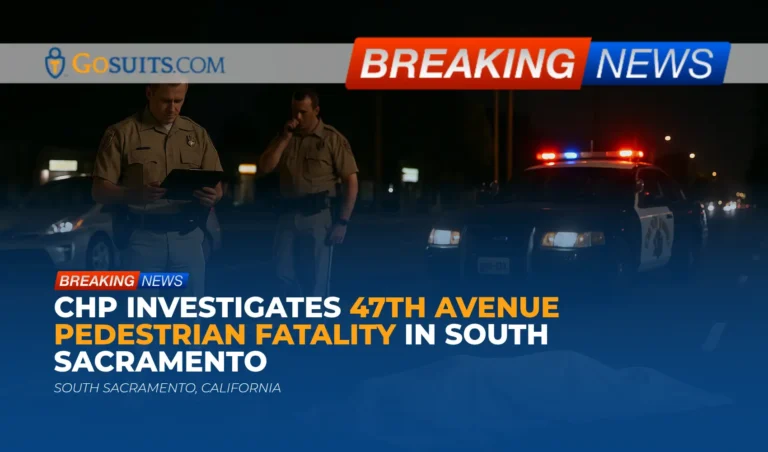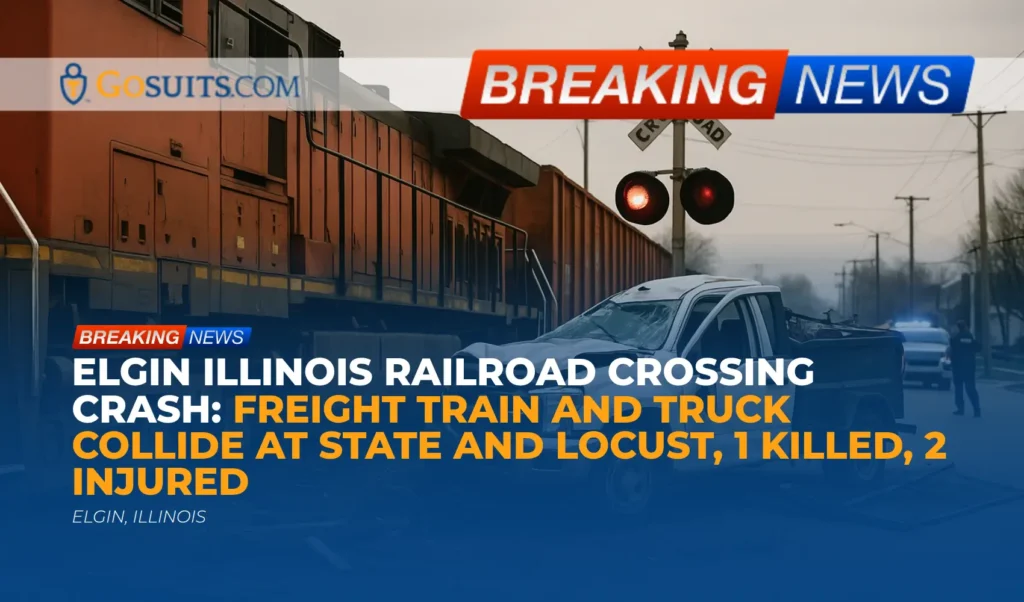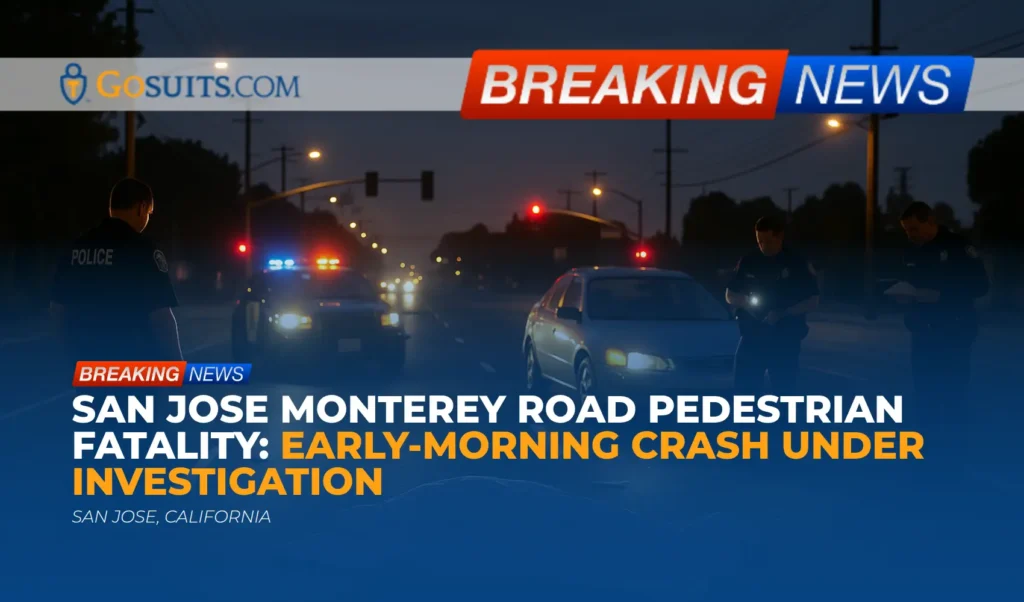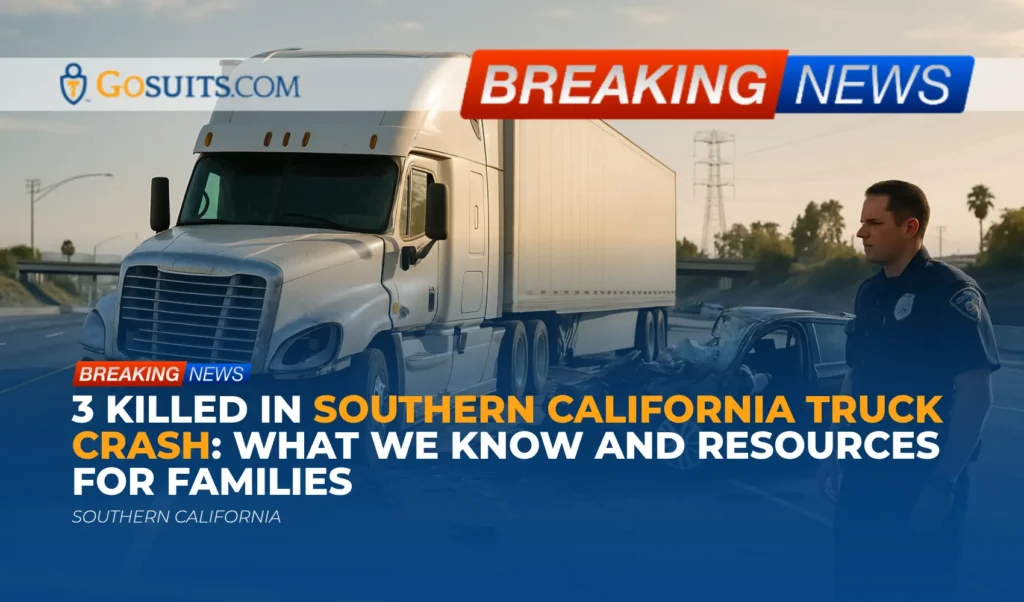- What is known about the 47th Avenue pedestrian fatality
- Where and when it occurred
- How fatal pedestrian crash investigations typically proceed
- Essential records to request and where to obtain them
- Rights of surviving family members under California civil law
- Potential civil liability issues raised by this scenario
- Insurance coverages that may apply after a fatal pedestrian crash
- Practical steps to protect a potential claim
- Community safety context and pedestrian risk data
- Public resources and supportive contacts in Sacramento County
- How wrongful death and survival actions differ
- Key California timelines and deadlines to keep in view
- Commentary from Gosuits Elk Grove, California Personal Injury Attorney
- Next steps: why timely action matters
What is known about the 47th Avenue pedestrian fatality
According to a California Highway Patrol news release, at approximately 9:31 p.m. on Sunday, October 19, a vehicle versus pedestrian collision occurred on 47th Avenue west of Franklin Boulevard. The report indicates a male pedestrian was walking southbound across the eastbound lanes of 47th Avenue. While in the second eastbound lane, the pedestrian fell in the roadway for reasons unknown and was struck by two passing vehicles: a 2017 Toyota Prius and a 2017 Ford Focus. Both drivers remained at the scene and provided statements. Despite lifesaving efforts, the pedestrian was pronounced deceased at the scene. Identification will be made by the Sacramento County Coroner’s Office after notification of next of kin. The South Sacramento Area office of the California Highway Patrol is investigating.
These initial facts may evolve as investigators gather additional information such as roadway measurements, vehicle inspections, witness accounts, and any available video. Families often have hard questions immediately following a crash; it is appropriate to seek information with compassion and to understand that official findings can take time.
Where and when it occurred
The crash occurred at night, around 9:31 p.m., on 47th Avenue west of Franklin Boulevard in the South Sacramento area of Sacramento County. Nighttime roadway conditions can affect visibility for both drivers and people on foot. Lighting, traffic volumes, speed limits, and the presence or absence of marked crosswalks are commonly examined in such investigations, especially along multi-lane corridors where gap selection and driver reaction times can be more challenging.
The South Sacramento CHP Area typically responds to major injury and fatal collisions in this region. Their investigation will aim to determine the sequence of events, contributing factors, and whether any violations or hazards played a role from a civil traffic perspective.
How fatal pedestrian crash investigations typically proceed
In fatal crashes investigated by CHP, officers usually document the scene and collect evidence that can include:
- Scene measurements and diagrams: Distances, lane widths, impact and rest locations, skid or yaw marks, and debris fields.
- Vehicle examinations: Damage profiles, lighting condition checks, and electronic data if present.
- Witness statements: Statements from drivers and bystanders to understand movements and timing.
- Environmental factors: Weather, lighting, roadway design, signage, and traffic control devices.
- Toxicology for involved parties: As appropriate, typically through the coroner for the decedent and potentially via chemical testing processes for drivers, consistent with California procedures.
Families commonly ask when they will receive the final collision report. CHP generally compiles a collision report that can be requested by authorized parties. Where the investigation remains active or where certain records are sensitive, some materials may be withheld or redacted until the case is complete. A coroner’s investigation runs in parallel to determine cause and manner of death and to make the formal identification.
Essential records to request and where to obtain them
Several official records can help families understand what happened. Agencies and links below are provided for orientation to public processes; availability may depend on requester status, privacy rules, and whether an investigation is still open.
CHP collision report
The collision report typically includes diagrams, narratives, and witness information. Requesting parties often include next of kin, legal representatives, or insurers. For crashes in this area, the South Sacramento Area office of the California Highway Patrol handles the investigation. Use the CHP’s office locator to find the correct Area office and request instructions:
https://www.chp.ca.gov/find-an-office
CHP also provides guidance on requesting collision reports and related records. Start with the Traffic section for collision reporting and follow the instructions provided by the handling Area office:
https://www.chp.ca.gov/traffic
Coroner identification and autopsy records
The Sacramento County coroner handles identification and cause/manner of death determinations and will notify next of kin. For certified death certificates, the California Department of Public Health (CDPH) Vital Records maintains statewide information on how to obtain death certificates:
https://www.cdph.ca.gov/Programs/CHSI/Pages/Vital-Records.aspx
Families can also consult the Sacramento County Sheriff-Coroner for local procedures on coroner reports. Contact information is available through the county and sheriff’s official channels. If a specific coroner report is requested, the office will advise on eligibility, timing, and any applicable fees under county policy and state law.
Public records requests
Additional materials such as 911 audio, traffic signal timing records, maintenance logs, or certain video footage held by public agencies may be requested under the California Public Records Act (CPRA). The California Attorney General provides a plain-language overview of the CPRA and general guidelines for requests:
https://oag.ca.gov/opengovernment/summary_public_records_act
Responses can vary based on exemptions, privacy concerns, or ongoing investigations. Public agency retention policies may be short, so time can be important when seeking time-sensitive records like video or raw traffic data.
Crash data and mapping
For broader safety context, UC Berkeley SafeTREC hosts the Transportation Injury Mapping System (TIMS), using statewide collision data for research and visualization. While not a substitute for a specific police report, TIMS can help communities understand local crash patterns:
Rights of surviving family members under California civil law
In California, surviving family members may bring civil claims related to a fatal crash. Two common types are wrongful death claims and survival actions. These claims are distinct, arise under different statutes, and are subject to specific deadlines. They exist to address losses suffered by the family and by the decedent’s estate, respectively. California applies a comparative fault framework, meaning that if more than one party contributed to a crash, responsibility for damages may be allocated among them proportionally.
California law sets time limits for filing civil cases. The general statute of limitations for wrongful death is two years from the date of death. See California Code of Civil Procedure section 335.1:
https://leginfo.legislature.ca.gov/faces/codes_displaySection.xhtml?sectionNum=335.1.&lawCode=CCP
If a public entity (for example, a city, county, or state agency) may be implicated in roadway design, maintenance, lighting, signal timing, or other public infrastructure issues, California’s Government Claims Act generally requires a written notice of claim within six months of the incident before filing a lawsuit. See Government Code section 911.2 for claim presentation deadlines:
https://leginfo.legislature.ca.gov/faces/codes_displaySection.xhtml?sectionNum=911.2.&lawCode=GOV
Because these timelines are strict and can have exceptions, families often consult with a seasoned attorney to understand which deadlines apply to their specific circumstances.

Potential civil liability issues raised by this scenario
Every crash is fact-specific. With the public information currently available, a few common civil law considerations may be relevant to an incident of this nature:
- Duty and standard of care for drivers: All drivers owe a duty to use reasonable care, keep a proper lookout, and travel at safe speeds for conditions. Nighttime visibility, lane configurations, and potential obstructions can influence what is “reasonable.”
- Pedestrian duties outside crosswalks: California Vehicle Code section 21954 generally requires a pedestrian crossing outside a marked crosswalk or unmarked crosswalk at an intersection to yield the right-of-way to vehicles close enough to constitute an immediate hazard. That duty does not relieve drivers from exercising due care for the safety of pedestrians. See Vehicle Code sections 21950 and 21954:
https://leginfo.legislature.ca.gov/faces/codes_displaySection.xhtml?sectionNum=21950.&lawCode=VEH
https://leginfo.legislature.ca.gov/faces/codes_displaySection.xhtml?sectionNum=21954.&lawCode=VEH
- Comparative negligence: California’s comparative fault rules can assign a percentage of responsibility to multiple parties. A pedestrian’s fall in a lane, driver reaction times, and roadway conditions can all factor into how fault is analyzed.
- Roadway design and lighting: In some cases, roadway geometry, lighting, traffic control, and speed management are examined. If a dangerous condition of public property is alleged, specialized notice and proof requirements apply under the Government Claims Act.
- Vehicle technology and visibility: Headlight performance, windshield condition, and lane positioning may be reviewed during the investigation to evaluate visibility at night.
- Evidence preservation: In multi-vehicle events with limited visibility, promptly preserving data such as dash camera footage, nearby business cameras, and any telematics can help clarify sequence and timing.
Given the report that both drivers stayed on scene and cooperated, investigators will have direct accounts from the motorists, which is often critical when a pedestrian falls in the roadway for unknown reasons. Toxicology results, scene measurements, and time-distance calculations may further inform whether avoidance was feasible under the circumstances.
Insurance coverages that may apply after a fatal pedestrian crash
Multiple insurance sources can potentially apply, depending on the facts and policy language. Possibilities include:
- At-fault driver’s liability coverage: Bodily injury liability insurance carried by a driver found negligent can respond to wrongful death claims.
- Uninsured/Underinsured Motorist (UM/UIM): If an at-fault driver is uninsured or underinsured, UM/UIM coverage on the decedent’s household auto policy may provide benefits, even though the person was a pedestrian. Policy language and residency specifics matter.
- Medical payments (Med-Pay): Some auto policies include no-fault medical payments coverage that can assist with medical expenses incurred before death.
- Public entity risk pools: If a claim involves alleged dangerous condition of public property, the public entity’s insurer or risk management pool becomes relevant after a timely claim is presented.
- Life insurance and funeral benefits: Separate from liability-based claims, life insurance or certain benefit programs may offer financial support to help with immediate expenses.
Insurers will typically conduct their own investigation. Before giving recorded statements or signing authorizations for broad records disclosures, it is wise to first speak with a qualified attorney. What someone says to an insurance company can be used against them later, and coverage issues can be nuanced.
Practical steps to protect a potential claim
There is no single “right” sequence after a tragedy, and the needs of each family come first. When and if people are ready to consider civil issues, these practical steps may help preserve important information:
- Consult an attorney early: Before contacting any insurance company, consider consulting an attorney for a free consultation about rights and options. Early guidance can prevent missteps with statements or releases. What is shared with insurers can be used later in a claim evaluation.
- Preserve evidence: Save any photos, videos, phone data, or relevant clothing. If businesses or residences nearby may have cameras, a prompt, respectful request to preserve footage can be important. Public records requests for traffic signal data or 911 audio should be made quickly due to retention limits.
- Request key records: Determine which records will be needed: CHP collision report, coroner documents, death certificates, and any medical records. Authorized requesters can follow public agency procedures to obtain them.
- Track deadlines: Calendar the two-year wrongful death statute and any six-month Government Claims Act deadline if public property issues are involved. Missing a deadline can foreclose claims.
- Be cautious with social media: Posts may be misunderstood. In sensitive matters, limited and careful online activity can prevent unnecessary complications later.
Community safety context and pedestrian risk data
Pedestrian safety remains a significant public health concern. Nationally, pedestrian fatalities have been a substantial share of traffic deaths in recent years. The National Highway Traffic Safety Administration (NHTSA) publishes ongoing research and prevention strategies directed at both drivers and people walking:
https://www.nhtsa.gov/road-safety/pedestrian-safety
California’s Office of Traffic Safety (OTS) supports local safety programs and tracks state-level trends, including grants for enforcement, engineering, and education. Resources on pedestrian and bicycle safety are available through OTS:
https://www.ots.ca.gov/traffic-safety-programs/pedestrian-and-bicycle-safety/
For local context and longer-term planning, agencies and community advocates sometimes use UC Berkeley SafeTREC’s TIMS to understand collision patterns across corridors and neighborhoods, including factors like time of day and roadway types:
On multi-lane corridors similar to 47th Avenue, nighttime crossings can be especially hazardous due to limited conspicuity, glare, and the time required to clear multiple lanes. Engineering countermeasures often discussed by safety professionals include high-visibility crosswalks, median refuges, lighting improvements, speed management, and rectangular rapid flashing beacons where warranted. Even where a pedestrian falls for an unknown reason, overall corridor design and operational speeds can influence the likelihood and severity of outcomes.
Public resources and supportive contacts in Sacramento County
Below are government resources that often intersect with the aftermath of a fatal traffic incident. Agencies will explain eligibility and process for releasing records, and some can direct families to additional support services.
- California Highway Patrol, South Sacramento Area:
- Investigating agency for this crash. Use the CHP office locator to confirm contact details and request instructions for a collision report.
- Find an office: https://www.chp.ca.gov/find-an-office
- Traffic information and collision reporting: https://www.chp.ca.gov/traffic
- Sacramento County Sheriff-Coroner:
- Handles identification and coroner investigations within the county. The office will notify next of kin and provide guidance on requesting coroner records consistent with law and policy.
- Access via county and sheriff official channels for current contact methods.
- California Department of Public Health, Vital Records:
- Information on obtaining certified death certificates.
- https://www.cdph.ca.gov/Programs/CHSI/Pages/Vital-Records.aspx
- California Public Records Act (CPRA) information:
- Guidance from the Attorney General on making public records requests to government agencies.
- https://oag.ca.gov/opengovernment/summary_public_records_act
- Statewide crash mapping and data for context:
- UC Berkeley SafeTREC’s Transportation Injury Mapping System (TIMS): https://tims.berkeley.edu/
How wrongful death and survival actions differ
Although they are often pursued together, wrongful death claims and survival actions compensate for different harms:
- Wrongful death: Brought by eligible heirs to address their losses arising from the death, which may include loss of financial support, companionship, and certain services the decedent would have provided. The focus is on the impact to the family.
- Survival action: Brought by the decedent’s estate to pursue claims the decedent could have pursued had they lived, such as certain economic losses before death. Its focus is on the decedent’s own claim that “survives” to the estate. The damages are different from wrongful death and can include particular categories defined by statute.
The personal representative of the estate or the successors in interest typically brings the survival action. Documentation like Letters of Administration or a declaration of successor can be required, depending on the circumstances. Because these procedures can overlap with probate steps, families often find it helpful to coordinate timelines and documentation early.
Key California timelines and deadlines to keep in view
- Two-year civil statute for wrongful death: California Code of Civil Procedure section 335.1 sets a two-year deadline from the date of death for most wrongful death claims. Link: https://leginfo.legislature.ca.gov/faces/codes_displaySection.xhtml?sectionNum=335.1.&lawCode=CCP
- Six-month Government Claims Act deadline: If a claim might involve a public entity (for example, claims regarding lighting, signage, signal timing, or roadway maintenance), a written claim is generally due within six months. See Government Code section 911.2: https://leginfo.legislature.ca.gov/faces/codes_displaySection.xhtml?sectionNum=911.2.&lawCode=GOV
- Public records retention: Some audio or video records may be deleted quickly under agency retention policies. A prompt CPRA request can help preserve access where appropriate. Overview: https://oag.ca.gov/opengovernment/summary_public_records_act
Other specialized timelines can apply depending on the facts and the parties involved. When in doubt, ask for a consultation and bring any letters or forms received from insurers or public entities.
Commentary from Gosuits Elk Grove, California Personal Injury Attorney
Our hearts are with everyone affected by this tragedy on 47th Avenue. The loss of a life on our roads is deeply painful for families and communities. This article is shared for general information so community members can better understand the processes that follow a serious collision and the types of questions that often arise.
Based on what has been publicly shared, investigators will look carefully at visibility, lane positions, driver attentiveness, and the sequence of events after the pedestrian fell into the lane. Nighttime, multi-lane corridors can create split-second scenarios where drivers have limited time and distance to react. At the same time, California law requires both drivers and pedestrians to use due care. In many cases, responsibility is not all-or-nothing; it may be apportioned among multiple factors, including environmental and roadway conditions. A thorough, patient review of the evidence is essential before any firm conclusions are drawn.
It is common for insurance carriers and large organizations to move quickly after an incident to gather statements and records. They know the rules, deadlines, and how to shape the narrative. People dealing with shock and grief often do not have the bandwidth to navigate this process, and that imbalance can affect how a claim is evaluated. Adjusters may ask for recorded statements, broad medical authorizations, or quick settlements. Without context, it is easy to say something that later gets used to minimize a claim or to overlook other responsible parties, such as additional drivers or entities responsible for road conditions.
A no-cost consultation can help clarify rights, deadlines, and practical next steps before speaking to any insurer. Even a short conversation can help someone avoid avoidable missteps, preserve critical evidence, and understand how different coverages might interact. That early understanding often makes a meaningful difference in how fairly a claim is handled.

Next steps: why timely action matters
- Identify the correct investigating agency and preserve records: Quickly determine which CHP Area is handling the report and request instructions for obtaining it. Traffic camera footage, 911 audio, and nearby business videos may be overwritten within days or weeks, so prompt requests can be decisive.
- Document the scene and conditions: Conditions change. Nighttime lighting levels, construction zones, or signage can differ even a short time later. Early photographs and measurements can capture details that might otherwise be lost.
- Avoid premature insurance statements: Before giving any recorded statement or signing any releases, seek a consultation. Statements can be taken out of context and used later to challenge liability or damages.
- Calendar civil deadlines: Two years for wrongful death is the general rule, but a six-month notice is required where a public entity may be implicated. Missing these dates can bar a claim outright.
- Coordinate family and estate considerations: Wrongful death and survival claims serve different purposes and sometimes involve probate steps. Early coordination helps ensure the correct parties are authorized and paperwork is in order.
- Assess all potential coverages: Liability, UM/UIM, Med-Pay, and other benefits can interact. Understanding the full insurance picture helps avoid leaving benefits unclaimed or accepting a settlement that forecloses other avenues.
- Protect well-being: Emotional and practical support are as important as legal steps. Public agencies can provide guidance on certificates, coroner processes, and victim support programs; taking care of immediate needs can make the rest of the process more manageable.
Taking these steps sooner rather than later helps ensure critical information is preserved and that rights are protected under California law and local procedures.
Sources and references
- NHTSA Pedestrian Safety overview: https://www.nhtsa.gov/road-safety/pedestrian-safety
- California Office of Traffic Safety, pedestrian and bicycle safety: https://www.ots.ca.gov/traffic-safety-programs/pedestrian-and-bicycle-safety/
- UC Berkeley SafeTREC, Transportation Injury Mapping System (TIMS): https://tims.berkeley.edu/
- California Vehicle Code section 21950: https://leginfo.legislature.ca.gov/faces/codes_displaySection.xhtml?sectionNum=21950.&lawCode=VEH
- California Vehicle Code section 21954: https://leginfo.legislature.ca.gov/faces/codes_displaySection.xhtml?sectionNum=21954.&lawCode=VEH
- California Code of Civil Procedure section 335.1 (wrongful death statute of limitations): https://leginfo.legislature.ca.gov/faces/codes_displaySection.xhtml?sectionNum=335.1.&lawCode=CCP
- California Government Code section 911.2 (claim presentation deadline): https://leginfo.legislature.ca.gov/faces/codes_displaySection.xhtml?sectionNum=911.2.&lawCode=GOV
- California Attorney General, Public Records Act overview: https://oag.ca.gov/opengovernment/summary_public_records_act
- California Highway Patrol office locator: https://www.chp.ca.gov/find-an-office
- California Highway Patrol, Traffic and collision reporting information: https://www.chp.ca.gov/traffic
- California Department of Public Health, Vital Records: https://www.cdph.ca.gov/Programs/CHSI/Pages/Vital-Records.aspx






